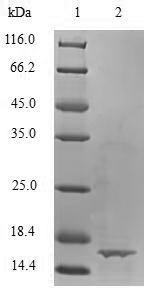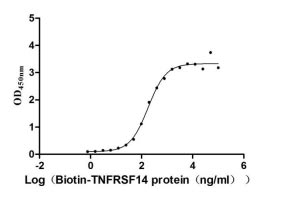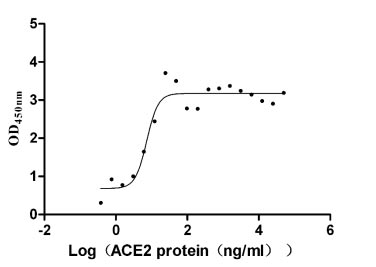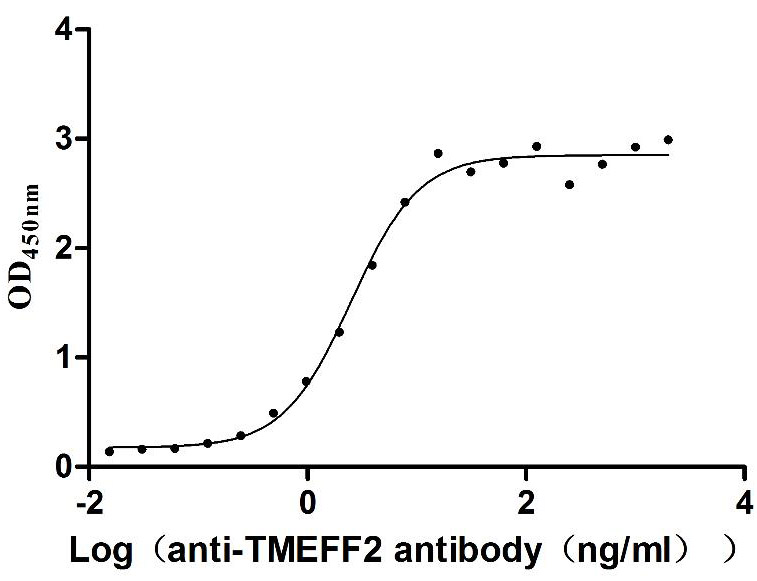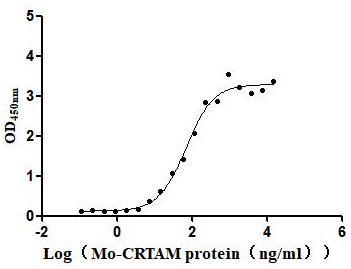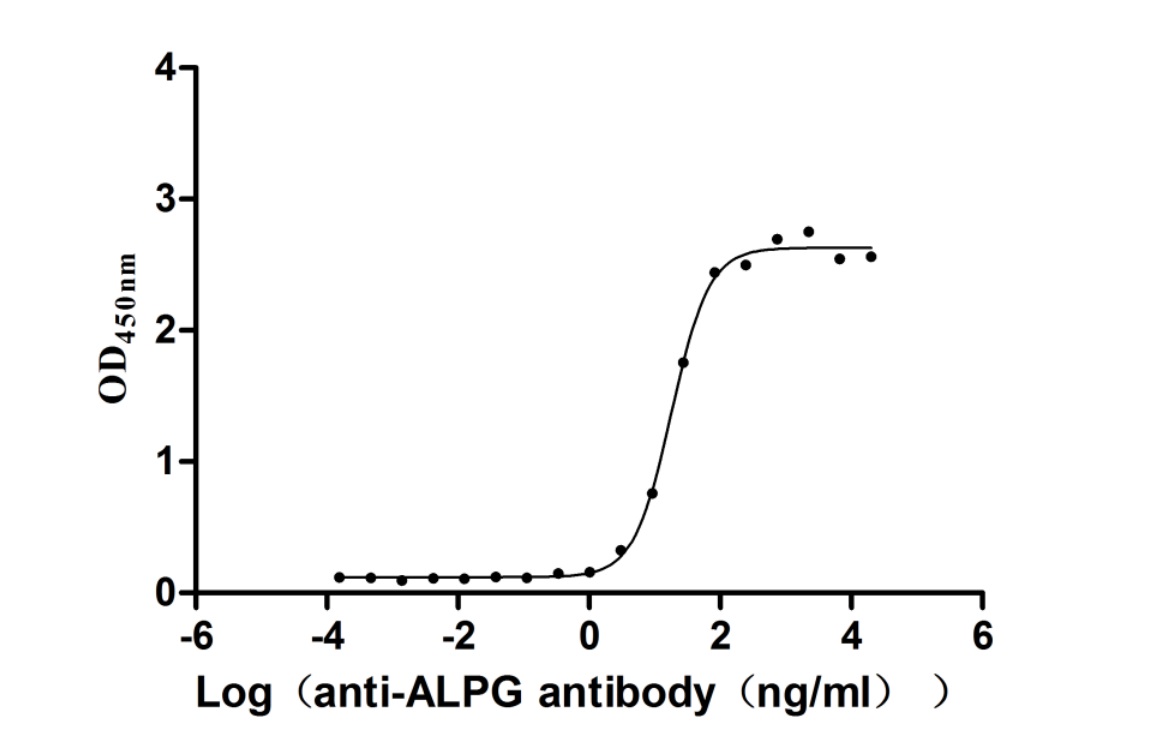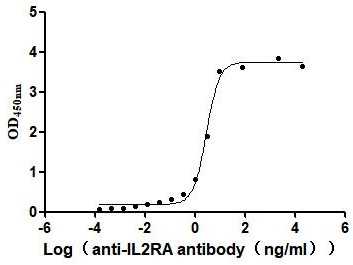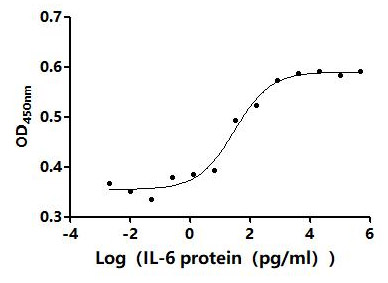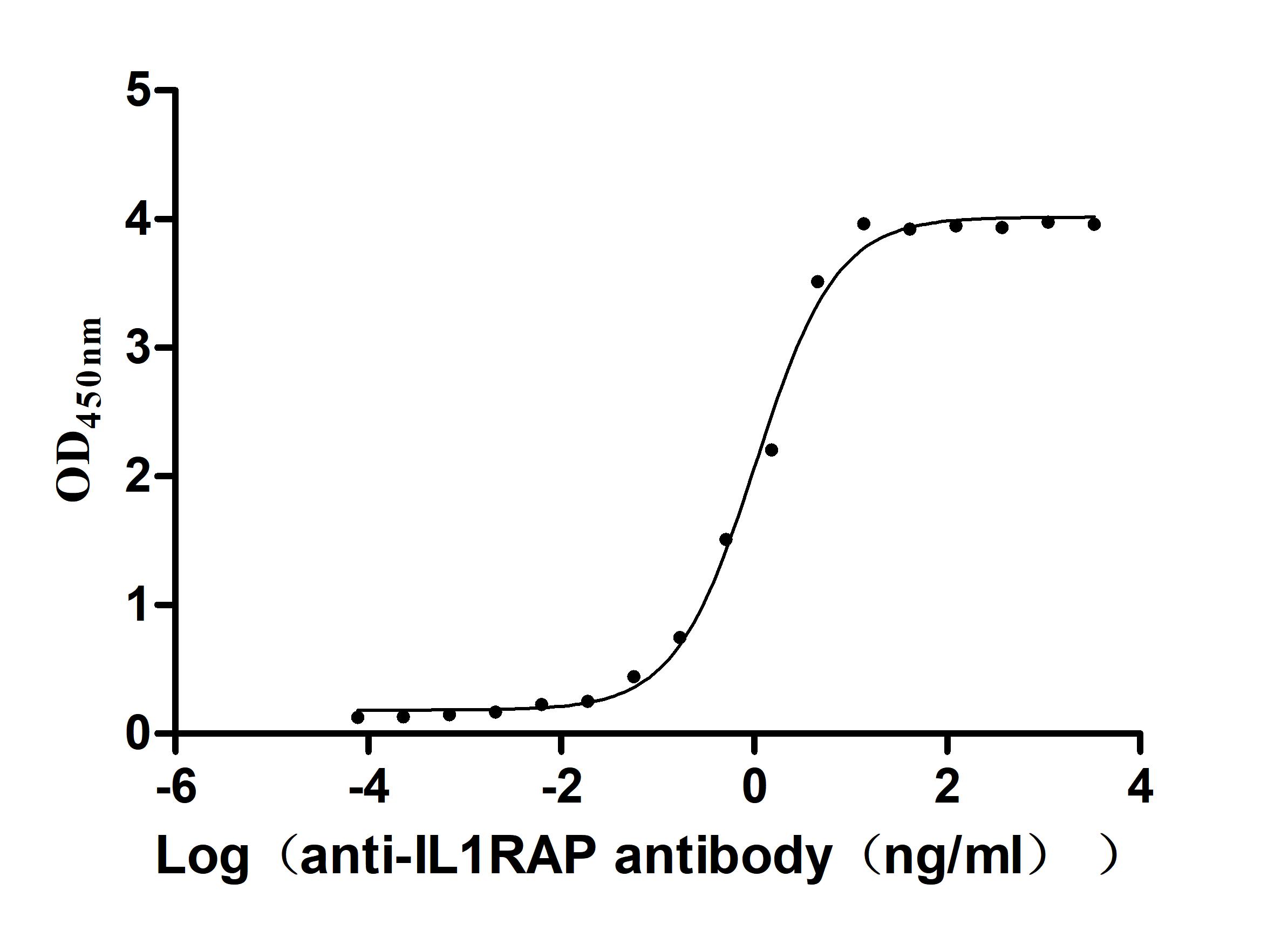Recombinant Bovine Transforming growth factor beta-1 proprotein (TGFB1), partial
In Stock-
中文名稱:牛TGFB1重組蛋白
-
貨號:CSB-EP023446BO
-
規(guī)格:¥2328
-
圖片:
-
其他:
產(chǎn)品詳情
-
純度:Greater than 90% as determined by SDS-PAGE.
-
基因名:
-
Uniprot No.:
-
別名:TGFB1; Transforming growth factor beta-1 proprotein [Cleaved into: Latency-associated peptide; LAP); Transforming growth factor beta-1; TGF-beta-1)]
-
種屬:Bos taurus (Bovine)
-
蛋白長度:Partial
-
來源:E.coli
-
分子量:16.8kDa
-
表達區(qū)域:279-390aa
-
氨基酸序列ALDTNYCFSSTEKNCCVRQLYIDFRKDLGWKWIHEPKGYHANFCLGPCPYIWSLDTQYSKVLALYNQHNPGASAAPCCVPQALEPLPIVYYVGRKPKVEQLSNMIVRSCKCS
Note: The complete sequence may include tag sequence, target protein sequence, linker sequence and extra sequence that is translated with the protein sequence for the purpose(s) of secretion, stability, solubility, etc.
If the exact amino acid sequence of this recombinant protein is critical to your application, please explicitly request the full and complete sequence of this protein before ordering. -
蛋白標簽:N-terminal 6xHis-tagged
-
產(chǎn)品提供形式:Liquid or Lyophilized powder
Note: We will preferentially ship the format that we have in stock, however, if you have any special requirement for the format, please remark your requirement when placing the order, we will prepare according to your demand. -
緩沖液:If the delivery form is liquid, the default storage buffer is Tris/PBS-based buffer, 5%-50% glycerol.
Note: If you have any special requirement for the glycerol content, please remark when you place the order.
If the delivery form is lyophilized powder, the buffer before lyophilization is Tris/PBS-based buffer, 6% Trehalose. -
儲存條件:Store at -20°C/-80°C upon receipt, aliquoting is necessary for mutiple use. Avoid repeated freeze-thaw cycles.
-
保質(zhì)期:The shelf life is related to many factors, storage state, buffer ingredients, storage temperature and the stability of the protein itself.
Generally, the shelf life of liquid form is 6 months at -20°C/-80°C. The shelf life of lyophilized form is 12 months at -20°C/-80°C. -
貨期:3-7 business days
-
注意事項:Repeated freezing and thawing is not recommended. Store working aliquots at 4°C for up to one week.
-
產(chǎn)品描述:
The DNA fragment encoding the 279-390aa of the Bovine TGFB1 protein was fused with N-terminal 6xHis tag gene and then was inserted into the expression vector, which was subsequently transformed into the E.coli for expression. The resulting product was further purified to obtain the recombinant Bovine TGFB1 protein. The purity of this recombinant TGFB1 protein is greater than 90% assessed by Bandscan software analysis combined with SDS-PAGE. This recombinant TGFB1 protein showed a band on the gel with a molecular weight of approximately 17 kDa.
TGFB1 is a gene encoding a protein named transforming growth factor beta-1 (TGFβ-1) and belongs TGF-beta family. TGFβ-1 is a multifunctional secreted protein that controls cell growth, cell proliferation, cell differentiation and other functions in many cell types. Almost every cell in the body produces TGFβ-1 and has its receptor. In term of immune system, TGFβ-1 plays an important role in tumorigenesis and metastasis.In the early stage of tumorigenesis, TGFb1 mainly plays an anti-cancer effect. TGFβ-1 has an inhibitory effect on the growth and proliferation of most cells. However, in the middle and late stages of the tumor, the TGFβ-1 receptors on the plasma membrane of tumor cells are reduced or absent, which results in tolerance to the growth inhibitory signal of TGFb1, and the proliferation of tumor cells is no longer restricted by the inhibitory effect of TGFβ-1.
-
Datasheet & COA:Please contact us to get it.
相關(guān)產(chǎn)品
靶點詳情
-
功能:Transforming growth factor beta-1 proprotein: Precursor of the Latency-associated peptide (LAP) and Transforming growth factor beta-1 (TGF-beta-1) chains, which constitute the regulatory and active subunit of TGF-beta-1, respectively.; Required to maintain the Transforming growth factor beta-1 (TGF-beta-1) chain in a latent state during storage in extracellular matrix. Associates non-covalently with TGF-beta-1 and regulates its activation via interaction with 'milieu molecules', such as LTBP1, LRRC32/GARP and LRRC33/NRROS, that control activation of TGF-beta-1. Interaction with LRRC33/NRROS regulates activation of TGF-beta-1 in macrophages and microglia. Interaction with LRRC32/GARP controls activation of TGF-beta-1 on the surface of activated regulatory T-cells (Tregs). Interaction with integrins (ITGAV:ITGB6 or ITGAV:ITGB8) results in distortion of the Latency-associated peptide chain and subsequent release of the active TGF-beta-1.; Multifunctional protein that regulates the growth and differentiation of various cell types and is involved in various processes, such as normal development, immune function, microglia function and responses to neurodegeneration. Activation into mature form follows different steps: following cleavage of the proprotein in the Golgi apparatus, Latency-associated peptide (LAP) and Transforming growth factor beta-1 (TGF-beta-1) chains remain non-covalently linked rendering TGF-beta-1 inactive during storage in extracellular matrix. At the same time, LAP chain interacts with 'milieu molecules', such as LTBP1, LRRC32/GARP and LRRC33/NRROS that control activation of TGF-beta-1 and maintain it in a latent state during storage in extracellular milieus. TGF-beta-1 is released from LAP by integrins (ITGAV:ITGB6 or ITGAV:ITGB8): integrin-binding to LAP stabilizes an alternative conformation of the LAP bowtie tail and results in distortion of the LAP chain and subsequent release of the active TGF-beta-1. Once activated following release of LAP, TGF-beta-1 acts by binding to TGF-beta receptors (TGFBR1 and TGFBR2), which transduce signal. While expressed by many cells types, TGF-beta-1 only has a very localized range of action within cell environment thanks to fine regulation of its activation by Latency-associated peptide chain (LAP) and 'milieu molecules'. Plays an important role in bone remodeling: acts as a potent stimulator of osteoblastic bone formation, causing chemotaxis, proliferation and differentiation in committed osteoblasts. Can promote either T-helper 17 cells (Th17) or regulatory T-cells (Treg) lineage differentiation in a concentration-dependent manner. At high concentrations, leads to FOXP3-mediated suppression of RORC and down-regulation of IL-17 expression, favoring Treg cell development. At low concentrations in concert with IL-6 and IL-21, leads to expression of the IL-17 and IL-23 receptors, favoring differentiation to Th17 cells. Stimulates sustained production of collagen through the activation of CREB3L1 by regulated intramembrane proteolysis (RIP). Mediates SMAD2/3 activation by inducing its phosphorylation and subsequent translocation to the nucleus. Can induce epithelial-to-mesenchymal transition (EMT) and cell migration in various cell types.
-
基因功能參考文獻:
- TGF-beta1 stimulated lubricin secretion by superficial zone chondrocytes at all densities with twice-a-week TGF-beta treatment. It is noteworthy that the daily treatment of TGF-beta1 increased lubricin much higher compared with twice-a-week treatment. PMID: 28578597
- hypoxia increased the expression of platelet-derived growth factor (PDGF) and transforming growth factor-beta1 (TGF-beta1) and decreased the expression of neprilysin (NEP), which contributed to the hypoxia-induced Endothelial-to-mesenchymal transition of pulmonary artery endothelial cells. PMID: 27373199
- TGF-beta1 modulates the expression of syndecan-4 in cultured vascular endothelial cells in a biphasic manner. PMID: 28019669
- Taken together, Staphylococcus aureus induces TGF-beta1 and bFGF expression through the activation of AP-1 and NF-kappaB in bovine mammary gland fibroblasts. PMID: 26948281
- localized to maternal septum in the interdigitation area of cotyledonary villi and caruncle PMID: 26382756
- The results identify TGFB1 and ESRRA as likely transcriptional regulators of rumen epithelial development and energy metabolism, respectively, and provide targets for modulation of rumen development and function in the growing calf. PMID: 24767884
- the combined treatment with TGF-beta1 and BMP-7 or treatment first with TGF-beta1 followed by BMP-7 was more effective than other treatment groups in both chondrogenic differentiation and SZP secretion. PMID: 23848497
- Tenascin-X promotes activation of latent TGF-beta1 and subsequent epithelial to mesenchymal transition in mammary epithelial cells. PMID: 24821840
- a detailed computational model for TGF-beta signalling that incorporates elements of previous models together with crosstalking between Smad1/5/8 and Smad2/3 channels through a negative feedback loop dependent on Smad7. PMID: 23804438
- Endogenous TGF-beta1 became more bioactive following activation of the transgene protein product in chondrocytes. PMID: 24105960
- A novel peptide, P2K, regulating TGF-beta1 signaling had an anabolic effect on bovine intervertebral disc cells and rabbit degenerated discs. PMID: 23124260
- Data show that TGF-beta pathways operate during ovarian fetal development, and fibrillin 3 is highly expressed at a critical stage early in developing human and bovine fetal ovaries. PMID: 21411746
- Role of TGF-beta1 and TNF-alpha in IL-1beta mediated activation of proMMP-9 in pulmonary artery smooth muscle cells: involvement of an aprotinin sensitive protease. PMID: 21722622
- Immunohistochemistry in rectus abdominis muscle from foetuses at 180 and 260 days post-conception PMID: 12441094
- vascular endothelial growth factor indirectly stimulates smooth muscle cell proliferation and migration through the modulation of basic fibroblast growth factor and transforming growth factor beta(1) released by endothelial cells PMID: 12591230
- Data show that as antral follicles develop, transforming growth factor (TGF)-beta3 is the most abundant TGF-beta isoform and TGF-beta1 protein levels decline in large follicles. PMID: 14502602
- TGF-beta 1 signaling pathway controls pericyte growth state and contractile phenotype PMID: 14609524
- Reactive oxygen species mediate TGF-beta1-induced TIMP-3 gene expression PMID: 15203191
- MGP plays a role in endothelial cell function, by increasing transforming growth factor-beta1 activity and stimulating VEGF expression PMID: 15456771
- Exogenous TGF-beta1, IGF-I, EGF and GH inhibited fetal bovine serum-deficiency-stimulated TGF-beta1 expression in mammary epithelium. PMID: 15747730
- ALK5 and Smad4 have roles in TGF-beta1-induced pulmonary endothelial permeability PMID: 16004987
- IGF-1 protects against TGF-beta1 mediated apoptosis in mammary gland. PMID: 16077202
- TGF-beta1 which is expressed in airways of asthmatics may contribute to irreversible airway remodeling by enhancing airway smooth muscle proliferation PMID: 16390551
- The roles of TGF-beta1 and somatotropic pathways proteins in control of the switch between survival and death of bovine mammary epithelial cells are reported. PMID: 17388018
- role for TGFbeta signaling in the mechanism of cellular mechanotransduction that is especially significant for joint lubrication PMID: 17968924
- Transforming growth factor-beta1 protects against pulmonary artery endothelial cell apoptosis via ALK5. PMID: 18456797
- the low friction of articular cartilage can be modified by TGF-beta1 and IL-1beta treatment and that the friction coefficient depends on multiple factors, including superficial zone protein localization and surface roughness PMID: 18683879
- Delayed parturition in clone calving may be associated with persistence of elevated TGF-beta-1 expression in late pregnancy. PMID: 19167845
- Sustained restoration of circulating latent TGFB1 to levels approaching the normal physiological range does not rescue the infertility phenotype caused by TGFB1 deficiency. PMID: 19383262
- TGF-beta1 downregulates caveolin-1 of cultured endothelial cells, involving ALK-5 receptor subtype PMID: 19710365
顯示更多
收起更多
-
亞細胞定位:[Latency-associated peptide]: Secreted, extracellular space, extracellular matrix.; [Transforming growth factor beta-1]: Secreted.
-
蛋白家族:TGF-beta family
-
數(shù)據(jù)庫鏈接:
Most popular with customers
-
Recombinant Human B- and T-lymphocyte attenuator (BTLA), partial (Active)
Express system: Mammalian cell
Species: Homo sapiens (Human)
-
Recombinant Macaca fascicularis Angiotensin-converting enzyme (ACE2), partial (Active)
Express system: Mammalian cell
Species: Macaca fascicularis (Crab-eating macaque) (Cynomolgus monkey)
-
Recombinant Human Tomoregulin-2 (TMEFF2), partial (Active)
Express system: Mammalian cell
Species: Homo sapiens (Human)
-
Recombinant Mouse Cell adhesion molecule 1 (Cadm1), partial (Active)
Express system: Mammalian cell
Species: Mus musculus (Mouse)
-
Recombinant Human Alkaline phosphatase, germ cell type (ALPG) (Active)
Express system: Mammalian cell
Species: Homo sapiens (Human)
-
Recombinant Human Interleukin-2 receptor subunit alpha (IL2RA), partial (Active)
Express system: Mammalian cell
Species: Homo sapiens (Human)
-
-
Recombinant Macaca fascicularis Interleukin 1 receptor accessory protein(IL1RAP), partial (Active)
Express system: Mammalian cell
Species: Macaca fascicularis (Crab-eating macaque) (Cynomolgus monkey)

